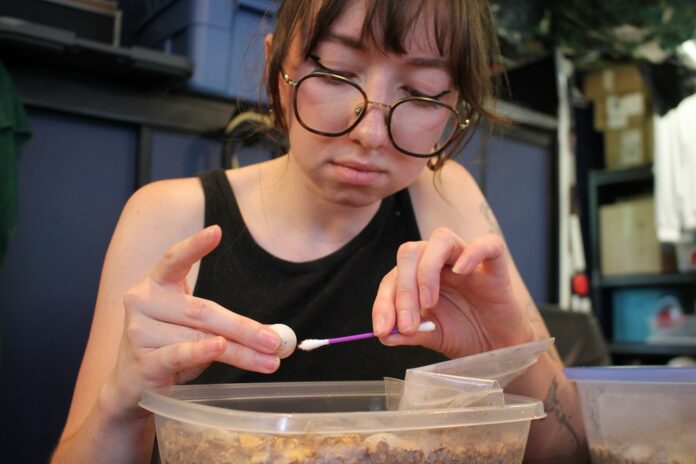While a raucous Turtle Guardians’ summer camp goes on outside, it’s quieter and darker inside the headquarters of the Haliburton-based charity as Emma Russett oversees nearly 7,460 turtle eggs.
Stacked in Tupperware containers all around her on a table, with others in incubators behind her, the lead incubator technician is doing her daily checks to ensure the artificial nests housing precious eggs have the correct amount of moisture.
The eggs have been excavated from about 340 nests. Turtle Guardian staffers have found them, or people have called the charity about them.
Founder, Leora Berman, said they are on the lookout for vulnerable nests. “In areas where the nest themselves might be predated (something has eaten eggs), or are more likely to be predated, so major corridors, roadways, and where the hatchlings would have difficulty, so highways, construction zones.”
She noted they have a permit to excavate those nests. It is illegal for the public to do so. “Each nest is treated very carefully, gets a unique identifier, the location is recorded, and then the nest comes here to Emma.”
Russett carefully opens one of the containers to check the condition of the eggs. She finds a moldy one. She has to redo the nest and cleans the egg with a bleach solution using a Q-tip.
The eggs have to be kept at a precise temperature and humidity to make sure that they are equally male and female. Berman says it’s called temperature-sex determination. Generally speaking, cooler means males and warmer means females. With climate change, there’s concern there won’t be any males. If the temperature fluctuates a lot, it tends to be predominately female as well.
A computer near Russett contains spreadsheets with nest codes, turtle type, excavation date, who excavated them and the exact locations of where they are from, the weights of the containers, and other notes, such as if they came from dead mothers. “We also exhume eggs from turtles that have passed,” Berman says.
It’s been an unusual year. Berman says they had a greater response from the public, but they’ve had very few Snapping turtles. This year was a good year for Blanding’s turtle nesting activity but yet they saw at least one dead each day this season, and these are already some of the rarest of turtles seen on roads.
Embryos have eyes
As of July 12, the embryos had eyes, and should have had heartbeats. “And we should be able to see those little guys moving around within the next week in the egg,” Berman says.
She said turtles in the nest will chirp to let each other know it’s time to get out of the nest. They have an egg tooth, similar to birds, to get out.
“It really is a lot of work because they’re all coming out at the same time,” Berman says.
She adds, “it’s like a little miracle to watch all these faces staring at you. It’s just amazing. Especially when these faces are so ancient.”
Legally, and biologically, the hatchlings should go back to where they were found within 10 days because they need to return to their territories to preserve DNA families and they will also be hungry.
If a member of the public has called in a nest, they are invited to be part of the release. It can happen in mines, hospital grounds, resorts, construction sites, beaches, and even restaurant and retail storefronts. This year, nests were also found “floating” due to the dry conditions followed by heavy rains. Hatchlings are released within a kilometre of where they were found.
“It’s a lot of fun releasing them,” Berman said. “We don’t just dump them. We release them so they have a fighting chance.” Berman likes to release them midday when predators are least active. They are placed metres apart from each other as they are a bit smelly and are soft and can be “tasty morsels” to other animals. She said once released, their instinct is to burrow in mud and eat the little bugs at the shores.
Without Turtle Guardians, Berman says where humans live, up to 99 per cent of the nests would be predated. She added .06 per cent would hatch and those hatchlings reach adulthood. “So, we’re increasing the chances six times.”
In essence, the Turtle Guardians are doing all of this work to see 15 turtles survive into adulthood. While shockingly low, Berman says “regardless of the low number, that would be close to the number had humans not colonized, developed and everything to the extent we have and keep doing. So we’re just trying to rebalance the scales. Our road survey program, turtle tunnels and the incubation program are to offset our human footprints.”
Russett takes the responsibility seriously. “I definitely can see that there are little lives inside of all of these. I understand the importance of it because they’re so precious and they take so much time to get to adulthood to create more lives.”
She will be excited to see them hatch and be released. “Probably a little sad to see them go but that’s where they’re meant to be.”
Berman said turtles are “dynamic and surprising, and they have their own personalities, which can even be seen in hatchlings, from shy, to scared, to brave or easygoing, based on body language.
“There’s definitely something magical and very sacred about turtles, so when September comes, it’s like something is missing in my life. You have empty nest syndrome, literally.”





